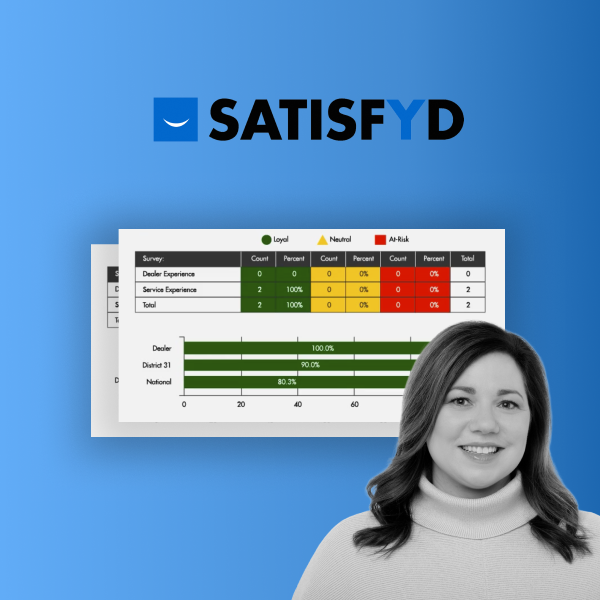Your equipment dealership service department is a primary source of revenue and a critical customer touchpoint. From new service orders to warranty fulfillment and inventory management, technician efficiency and accuracy keep your service center running smoothly and contribute to your bottom line.
However, maintaining a successful service department can be challenging without the right insights. Service Managers must coordinate technician schedules and parts inventory while ensuring timely repairs and keeping customers happy – all tasks that require strategic planning and up-to-date information about the many moving parts within your service operations.
Rather than acting on gut instinct or their best guesses, dealers can use data analytics to monitor service performance, identify areas for improvement, and implement proactive strategies to enhance efficiency, customer satisfaction, and profitability.
In this blog post, we'll explain four ways a business intelligence (BI) solution for heavy equipment dealers can help your service department drive operational excellence and achieve sustainable growth.
#1 Analyze Data From Multiple Sources on a Daily Basis
You rely on many business systems to keep your dealership running smoothly, and your BI solution should be able to seamlessly extract and combine data from all of them to create a clear picture of performance. This is especially true in your service department, where factors like labor efficiency and inventory availability play such a critical role in operational success and profitability.
An all-in-one BI solution gives you a complete picture of your service department — and the rest of your dealership — by combining data from multiple sources inside a single analytical database, from which you can create an endless variety of reports and dashboards.
What’s more, you can generate these analyses daily, giving everyone, from executive stakeholders to managers in the service center, an up-to-date view of critical information.
This level of multi-source analysis allows business users to make informed decisions on the fly and adapt quickly to what’s happening in the service department. Managers can compare the latest inventory report to open service requests to quickly determine the most efficient fulfillment option. Leadership teams can see if the department is on track to meet monthly targets before the reporting period ends rather than looking back at old numbers after the fact.
#2 Compare Figures Across Branches
If your equipment dealership has multiple branches, you need the ability to generate both detailed insights on each branch, as well as reports that compare dealership key performance indicators (KPIs) across different locations. Your BI solution should allow you to evaluate performance at an individual location, then zoom out to the complex level, regional level, all the way to the entire brand level.
These comparative analyses allow you to see similarities and differences between branches. Then, you can dig into the details to start determining why certain locations are excelling while others might be struggling.
For example, if you learn that one branch has a significantly larger volume of service orders than another branch fifty miles away, you could then evaluate foot traffic, staff levels, and the number of existing customers at each branch to determine whether the lower-performing branch simply has a smaller footprint, or if there’s an issue with staffing or customer engagement.
By understanding the unique challenges and successes of each branch, you can implement tailored strategies to optimize overall performance and ensure consistency in service quality across your entire brand.
#3 Visualize Tech Efficiency by Personnel and Revenue Stream
Technician efficiency is one of the most critical metrics in the service department. It helps you understand not only how effective each staff member is, but how their work ties back to various revenue streams and the overall profits created by service operations.
A comprehensive BI solution allows you to drill down into your tech efficiency numbers, so you can measure efficiency on an individual basis, by store, or by region. Plus, you can segment efficiency by revenue stream to see differences in performance on various types of work orders – like new customers, warranty work orders, and internal sales.
This insight allows you to see which technicians are performing well, and in which types of jobs. You can also zoom out and track similar trends by location or complex, then use your findings to identify potential concerns and improvement opportunities.
For example, if you see that techs are generally pretty efficient at completing new customer work orders but slower to complete warranty orders, you can then dig deeper to determine whether delays are due to backordered parts, financing, or competing priorities from other types of work orders.
#4 Identify Top Performers and Inform Training Programs
Step into any dealership service department and ask the Service Manager who their most efficient technician is. Most leaders will know who sits in the top few spots, but they can’t often tell you the name of every tech that’s hitting over 100% efficiency.
A BI and analytics solution helps your dealership identify not only the top-performing technicians but also the factors contributing to their success, giving you a detailed picture of technician performance. It also allows you to segment technicians by certification level, tenure, and other factors rather than comparing everyone one-to-one, which can give you a more accurate understanding of each employee’s results.
See who’s performing well and who might be falling behind the pack using data related to completed service requests, customer satisfaction scores, and resolution times. And rather than ranking your top performers numerically, you can see everyone who’s billing at or over their goals and recognize all of them for their exemplary work.
You can use this information to establish best practices for training and goal setting. It can also help you create curated performance improvement plans for technicians below the curve, based on the specific areas where they’re missing the mark.
See How Data Can Transform Your Dealership Service Department
The right BI solution can give you end-to-end operational visibility and pave the way for strategic improvements across your entire dealership.
Watch our on-demand webinar to hear how Young’s Equipment uses TARGIT’s BI solution for dealers to manage their service department and inform daily decisions. You’ll hear more details about the points shared in this blog post, plus even more inspiration on how you can use BI to streamline operations and manage performance in your service department.








